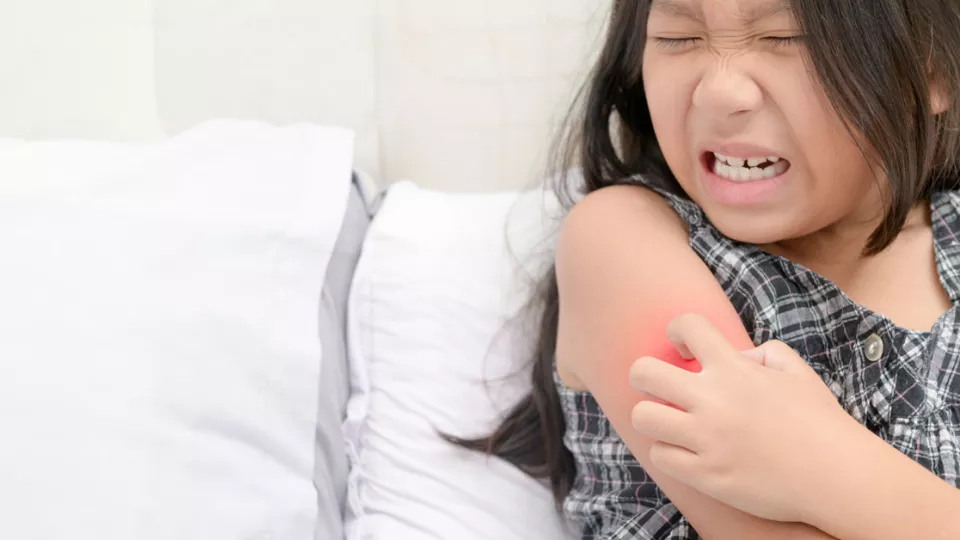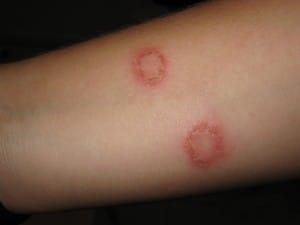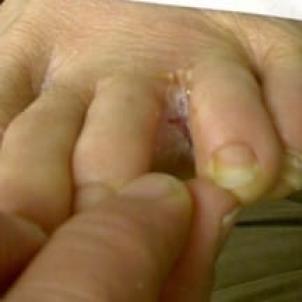
Getting to the Root of Ringworm Causes and Prevention
I often use my daughter’s childhood ailments as blog topics, but this topic, a type of fungal infection, is something I have experienced personally. The infection is itchy and uncomfortable—Ringworm!
What is ringworm?

Did you know that ringworm is not actually caused by a worm? It’s a common fungal infection in school-age children. The reason it’s called ringworm is because the fungal infection forms a circle of red scaly skin—similar to how a worm looks when it touches end to end. As humans, we have many bacteria and fungi that live on our skin; some are useful and others can cause infections. The bacteria that cause ringworm are not the good kind. Continue reading to learn about signs, symptoms, diagnosis and prevention. The scientific name for ringworm is tinea. The condition can also be named for where it occurs on your child’s body.
- Ringworm on your child’s scalp—tinea capitus
- Ringworm on your child’s body—tinea corporis
- Ringworm on your child’s feet or hands—tinea pedis or manus
The condition is caused by skin fungi called dermatophytes, which live on top of skin and typically do not invade deep inside the skin. Additioanlly, dermatophytes do not live inside the mouth. A person can have the fungus on several areas of the body at the same time.
What are ringworm signs and symptoms?
- Itchy and unpleasant sensation on your child’s skin
- Raised, red patches that can blister or ooze
- Scaly, crusted rash (does not always need to be a circular shape)
- Sharply defined edges, sometimes darker around the edge
Ringworm is very contagious and spreads easily from person to person. Other ways it can spread include:
- Pets, especially cats and dogs—your child can actually give your pet ringworm, and vice versa.
- Playing in soil.
What are the types of ringworm?
There are five types of ringworm:
- Tinea barbea, which is found on the bearded area of the face in adolescent and adult males. It is also called “barber’s itch.” It is red and scaly with borders that are not clearly defined.
- Tinea capitis, which is found on the scalp, usually in late childhood and teenagers. This will usually leave bald spots.
- Tinea corporis, which is the rash on the skin that is often but not always ring-like. It can have an active reddened border that grows.
- Tinea cruris, which is found in the groin area and is usually reddish-brown. This is also known as “jock itch.” It can mimic yeast infections, psoriasis or just chafing from tight clothing.
- Tinea manus or pedis, which is found on the hands or feet and shows up often in the spaces between the fingers and toes. It can cause thickening, itchy, scaling, red and itchy skin. It can also be on the heels or soles of the feet. Nails can be thickened, discolored, brittle and crumbly.
How is ringworm diagnosed and treated?

If you feel your child has ringworm, contact their pediatrician for proper diagnosis and treatment. Treatment may involve an antifungal cream. If the rash does not heal with the cream, your child’s pediatrician may prescribe medicine to be taken by mouth. During treatment, be sure to keep the child clean and dry and wash all clothes, bed sheets and towels every day. Following the pediatrician’s treatment regimen is important because ringworm can get worse and make your child very sick with a widespread fungal infection. If your child’s ringworm is worsening, he or she will have these signs and symptoms:
- Fever
- Pus or drainage
- Rash is warm to the touch
- Red streaks
- Swelling
- Worsening and spreading redness
How can I prevent ringworm in my child?
Proper hand washing and skin care is important in preventing ringworm. Remind your child to wash their hand frequently with running water, soap and plenty of friction. Other ways to prevent ringworm:
- Encourage your child not to share clothing, towels, hair brushes and accessories, combs or other personal items with others.
- Encourage your child to wear sandals in locker rooms or around a pool.
- Wash your child’s sports clothing, towels and linen regularly.
- Keep your child’s skin clean and dry.
- If your child complains of itchiness, inspect their skin daily for signs of ringworm.
- Shampoo your child’s hair regularly.
- Don’t dress your child in tight clothing.
- Remind your child not to touch bald or itchy spots on pets.
- Take your pet to the veterinarian if they contract ringworm. This will help avoid your pet from spreading the condition to the rest of the family and other pets.
The information in this blog post can help protect you and your family from ringworm and promote skin health. Our skin is our biggest organ and our best protection!
Many thanks to Terry Renteria, RN, wound ostomy and continence nurse (WOCN) specialist at Children’s Hospital Los Angeles for her advisement of this RN Remedies blog post.

